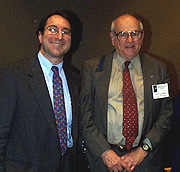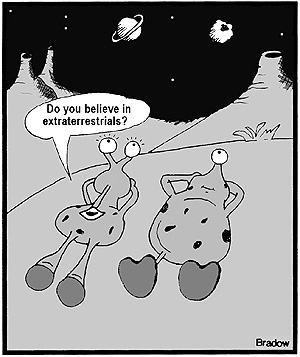
| T H E N I H C A T A L Y S T | J U L Y – A U G U S T 2001 |
|
|
|
LIFT-OFF!ASTROBIOLOGY SYMPOSIUM AT NIH MAY SEED INTEREST GROUP |
 |
|
Joint
Mission: NICHD's Josh Zimmerberg (left) and Baruch Blumberg, director
of the NASA Astrobiology Institute, on Earth at NIH in April
|
When the shuttle Atlantis was launched from the Kennedy Space Center February 7, 2001—an hour after sunset and under a full moon—it generated what seemed like a megaton of explosive light and sound and an equal amount of awe in Joshua Zimmerberg, chief of the NICHD Laboratory of Cellular and Molecular Biophysics and director of the NASA/NIH Center for Three-Dimensional Tissue Culture.
Zimmerberg was among the scientists who watched from the ground as the shuttle zoomed into space carrying a 16-ton microgravity laboratory to be installed at the international space station for the purpose of scientific research, including the study of how cells—especially immune cells—respond under conditions of microgravity.
This space laboratory is one of a growing number of collaborations between NASA, its Astrobiology Institute (NAI; see The NIH Catalyst, "Astrobiology and the Search for Origins," May–June 2000), and NIH.
A video of the launch electrified participants at the first joint NAI-NIH symposium, which was held here earlier this spring and featured such topics as pathogenesis in modeled microgravity, molecular perspectives on the extremes of life, human oral biofilms, microbial mats, and the origins of stars and planets.
Zimmerberg is in the throes
of creating an Astrobiology Interest Group and can be reached at 6-6571 or by
e-mail. ![]()
 |